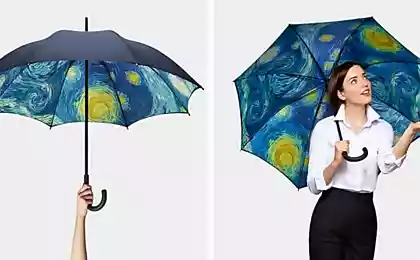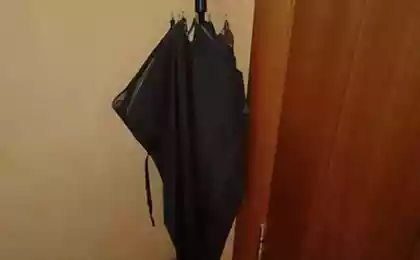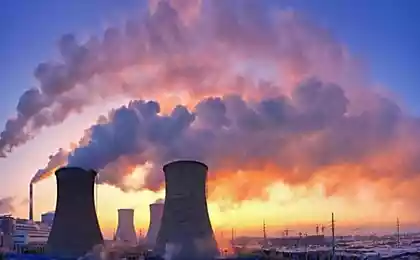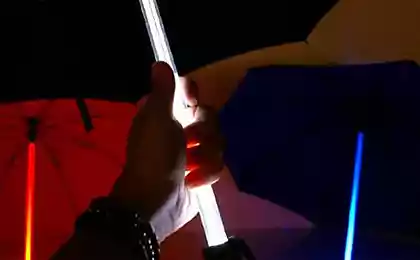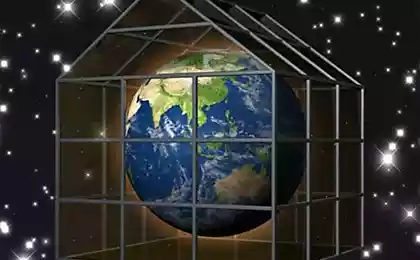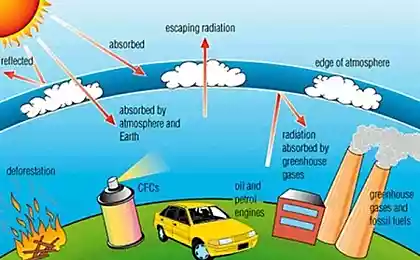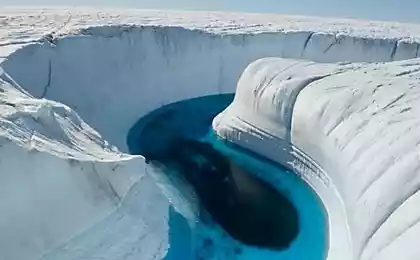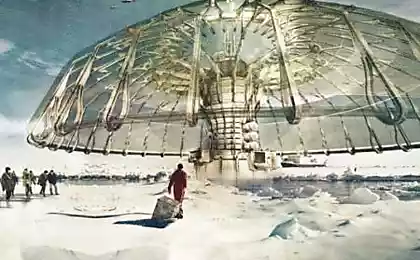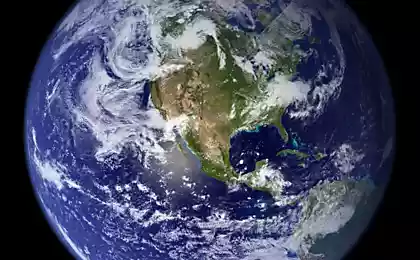554
Can a giant umbrella to save us from global warming?
Our rapidly warming world may create serious problems to civilization in the coming decades. Can giant space umbrella (sounds ridiculous, but true) to help cool our planet? In the end, the solutions that will help us in the fight against global warming, this is a major issue on the agenda not day — decades, maybe centuries.
One of the proposals to cope with the increasing heat may cause surprise: the giant space umbrella. We have accidentally changed the climate, why not make additional changes that will return everything as it was?
The idea is incredible, but it can work. Reducing the amount of light reaching the planet, can quickly cool the Earth, while not increasing the level of carbon dioxide. If you compare with the asteroid that led to the extinction of the dinosaurs, blocking 90% of the sun's rays, we need only 2-4%, to return Earth's climate to pre-industrial level.
Space umbrellas are interested in the most respected institutions, from the Royal society and NASA to the European Union. Even the most respected authority on global warming, the intergovernmental panel on climate change (IPCC), is interested in this issue.
The idea is based on the millennia-tested umbrella, but the overall plan much more complex. To evenly cool the planet, using a system that is constantly moving, the shadow need to install in the area of outer space where the gravity of Earth and Sun is balanced — point L1 — a million miles away from us.
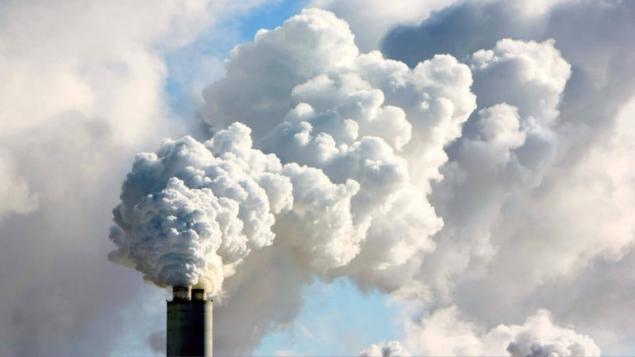
First conceived by engineer James Earle in 1989, the project was a huge glass shield in 2,000 kilometers wide, the structure is so heavy that it had to collect on the moon. More recent proposals included clouds of lunar dust, 55 000 fine meshed mirrors or tiny umbrellas that surround the Ground ring. And while you don't get bored, how do you mean: move the Earth further from the Sun by explosion equivalent to five thousand million million hydrogen bombs.
To create a shadow in the external space is not so easy. Currently launching a kilogram of payload into orbit costs about 10-20 thousand dollars, and for the moon we didn't go since 1972. That technology is justified, it should be very easy to gather on the Ground.
Astronomer Roger angel thinks he's found the answer: 16 trillion flying space robots. Each weighing about a gram is like a butterfly — and deflects sunlight transparent film, riddled with tiny holes. The lenses should be of a thickness less than one hundredth of a human hair. Because nothing thinner will not stop the light of the sun, said the astronomer.
The robots will be able to bring yourself into orbit using ion engine on solar energy, whose technology is already used by Orbiter, ESA's Smart-1, and form a cylindrical cloud with a width of 100 000 kilometers. After that, they will need to control satellites, so that they do not face each other and to avoid being blown sunlight. If they quit, they will go free swimming and will fall back to Earth.
Electromagnetic gunIn total we need to send 20 million tonnes into space — still too much to us helped chemical rockets. Angela is the decision so outrageous that a long time was considered impossible, because it violated the laws of physics: the giant electromagnetic gun built into the mountain.
This system could accelerate the load to start from the top of the mountain using a form of electromagnetic energy, converting the electricity in thrust. The so-called Lorentz force is in the basis of the magnetic cushion trains, Magauov, and the latest weapons of the U.S. Navy. This way of launching could reduce the cost of launch to $ 10 per kilogram, which would run the desired shadow in orbit for a couple of trillion dollars.
There was only one problem: this technology does not exist yet.
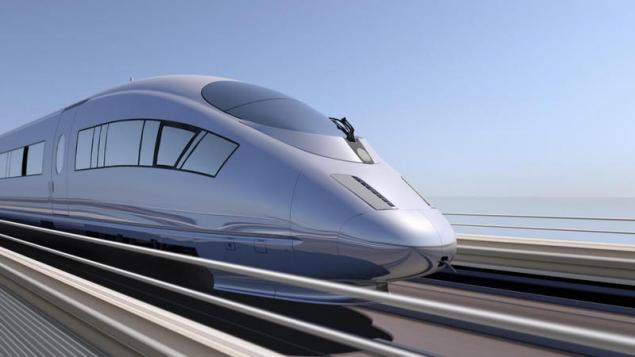
While the easiest and cheapest option is to simulate a natural disaster. The cooling effect of falling asteroids and volcanic eruptions — such as those that killed the dinosaurs — is reduced to sulphur emissions generated by the evaporation of sulfur-rich rocks. These particles can be suspended for many years, increasing the density of the atmosphere and reflecting sunlight back into space. The last time this happened in 1991, when the eruption of mount Pinatubo resulted in the release of thousands of tons of sulfur dioxide. In subsequent years, the Earth cooled for a few tenths of a degree.
It has been estimated that one kilogram of sulfur could offset the effect of warming by several hundred thousand kilograms of carbon dioxide. In the context of global warming artificial volcano may be a cure.
Ozone fearwhether it will Work in practice is not clear. How quickly will cool down the Earth and how much? Will there be a shadow on the planet uniform? In the end, the cooling of even a few degrees more than expected, will be catastrophic. Dr. Matthew Watson, a volcanologist at Bristol University, speaks to other fears. "People say, Oh, we can do all cooling to -20 degrees or something like that, and I think that's nonsense. We know that volcanoes do with global temperature".
According to Watson, the real risks are the unintended consequences. Take, for example, ozone, a chemical that protects the Earth from cancer-causing ultraviolet rays. The Montreal Protocol of 1987 banned the use of ozone destroying chemicals, the so-called chlorofluorocarbons (CFCs) once widely used in refrigerators and aerosol cans. And still every spring in the ozone layer over Antarctica there is a hole.
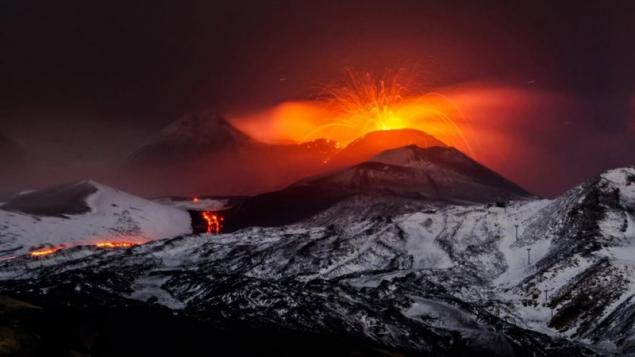
Sulfate particles, as it turns out, is also perfectly destroy ozone. Professor Alan Shy from Rutgers University wrote a report about the risks of such intervention. "We saw extensive destruction of the ozone layer after the two major volcanic eruptions. This will happen all the time."
Then there is the sky itself. Even on a Sunny day the light-scattering particles can make the blue sky white. With sulfate reflector will be more "diffuse radiation" instead of direct sunlight. So, for example, light on a cloudy day, although the sun is not visible.
Although volcanic eruptions can introduce huge amounts of greenhouse gases into the atmosphere, the increase in carbon dioxide actually slows down. No one knows why, but as an option — the plants prefer a white sky: they grow better because it is not so hot. This is a good argument against this form of intervention. The result is difficult to predict, since the whole system is very complex.
Given these uncertainties, Dan Lunt from Bristol University in the UK and his colleagues have simulated a variant with an umbrella to predict climatic effects.
The model included three scenarios: pre-industrial world, the "greenhouse world", which is four times more atmospheric carbon dioxide than now and which is 6 degrees warmer, and the "shadow world" in which the sun is 4% less, but where the same carbon dioxide.
It turned out that the shadow can exactly compensate for the warming in a greenhouse world — geo-engineering could be successful. Compared to pre-industrial time, the tropics would be 1.5 degrees colder high latitudes and warmer by 1.5 degrees. And even with the space sun shade, sea ice will be less. Because the planet will be evenly shaded.
"The shadow world" was also drier, with a 5 percent decrease in precipitation in average. "If you reduce the global temperature to pre-industrial level, you will get excessively dry planet. The only way to handle this is to leave a bit of global warming," said Ben Kravitz, a climate scientist, who did not participate in the study.
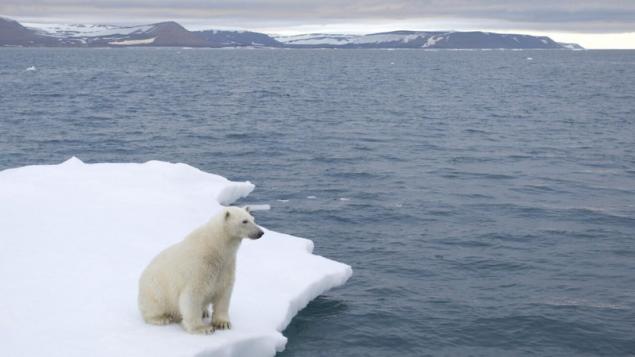
In imperfectly designed world some countries can obtain a more advantageous position than others. Space sunshade could protect some areas from flooding, but to make the other drier. And here the question is purely political.
Can space umbrella to stop global warming? Climate change may cause more climate change. There are many things that we don't know, and to understand geoengineering have to do more work. You need to weigh the pros and cons.
"Ten years ago, the warming of 8.5 degrees it seemed apocalyptic, incredible. Today does not seem," says Watson. If we can intervene now? Completely. Should we? Of course. published
P. S. And remember, only by changing their consumption — together we change the world! ©
Join us in Facebook , Vkontakte, Odnoklassniki
Source: hi-news.ru/space/mozhet-li-gigantskij-zont-spasti-nas-ot-globalnogo-potepleniya.html
One of the proposals to cope with the increasing heat may cause surprise: the giant space umbrella. We have accidentally changed the climate, why not make additional changes that will return everything as it was?
The idea is incredible, but it can work. Reducing the amount of light reaching the planet, can quickly cool the Earth, while not increasing the level of carbon dioxide. If you compare with the asteroid that led to the extinction of the dinosaurs, blocking 90% of the sun's rays, we need only 2-4%, to return Earth's climate to pre-industrial level.
Space umbrellas are interested in the most respected institutions, from the Royal society and NASA to the European Union. Even the most respected authority on global warming, the intergovernmental panel on climate change (IPCC), is interested in this issue.
The idea is based on the millennia-tested umbrella, but the overall plan much more complex. To evenly cool the planet, using a system that is constantly moving, the shadow need to install in the area of outer space where the gravity of Earth and Sun is balanced — point L1 — a million miles away from us.

First conceived by engineer James Earle in 1989, the project was a huge glass shield in 2,000 kilometers wide, the structure is so heavy that it had to collect on the moon. More recent proposals included clouds of lunar dust, 55 000 fine meshed mirrors or tiny umbrellas that surround the Ground ring. And while you don't get bored, how do you mean: move the Earth further from the Sun by explosion equivalent to five thousand million million hydrogen bombs.
To create a shadow in the external space is not so easy. Currently launching a kilogram of payload into orbit costs about 10-20 thousand dollars, and for the moon we didn't go since 1972. That technology is justified, it should be very easy to gather on the Ground.
Astronomer Roger angel thinks he's found the answer: 16 trillion flying space robots. Each weighing about a gram is like a butterfly — and deflects sunlight transparent film, riddled with tiny holes. The lenses should be of a thickness less than one hundredth of a human hair. Because nothing thinner will not stop the light of the sun, said the astronomer.
The robots will be able to bring yourself into orbit using ion engine on solar energy, whose technology is already used by Orbiter, ESA's Smart-1, and form a cylindrical cloud with a width of 100 000 kilometers. After that, they will need to control satellites, so that they do not face each other and to avoid being blown sunlight. If they quit, they will go free swimming and will fall back to Earth.
Electromagnetic gunIn total we need to send 20 million tonnes into space — still too much to us helped chemical rockets. Angela is the decision so outrageous that a long time was considered impossible, because it violated the laws of physics: the giant electromagnetic gun built into the mountain.
This system could accelerate the load to start from the top of the mountain using a form of electromagnetic energy, converting the electricity in thrust. The so-called Lorentz force is in the basis of the magnetic cushion trains, Magauov, and the latest weapons of the U.S. Navy. This way of launching could reduce the cost of launch to $ 10 per kilogram, which would run the desired shadow in orbit for a couple of trillion dollars.
There was only one problem: this technology does not exist yet.

While the easiest and cheapest option is to simulate a natural disaster. The cooling effect of falling asteroids and volcanic eruptions — such as those that killed the dinosaurs — is reduced to sulphur emissions generated by the evaporation of sulfur-rich rocks. These particles can be suspended for many years, increasing the density of the atmosphere and reflecting sunlight back into space. The last time this happened in 1991, when the eruption of mount Pinatubo resulted in the release of thousands of tons of sulfur dioxide. In subsequent years, the Earth cooled for a few tenths of a degree.
It has been estimated that one kilogram of sulfur could offset the effect of warming by several hundred thousand kilograms of carbon dioxide. In the context of global warming artificial volcano may be a cure.
Ozone fearwhether it will Work in practice is not clear. How quickly will cool down the Earth and how much? Will there be a shadow on the planet uniform? In the end, the cooling of even a few degrees more than expected, will be catastrophic. Dr. Matthew Watson, a volcanologist at Bristol University, speaks to other fears. "People say, Oh, we can do all cooling to -20 degrees or something like that, and I think that's nonsense. We know that volcanoes do with global temperature".
According to Watson, the real risks are the unintended consequences. Take, for example, ozone, a chemical that protects the Earth from cancer-causing ultraviolet rays. The Montreal Protocol of 1987 banned the use of ozone destroying chemicals, the so-called chlorofluorocarbons (CFCs) once widely used in refrigerators and aerosol cans. And still every spring in the ozone layer over Antarctica there is a hole.

Sulfate particles, as it turns out, is also perfectly destroy ozone. Professor Alan Shy from Rutgers University wrote a report about the risks of such intervention. "We saw extensive destruction of the ozone layer after the two major volcanic eruptions. This will happen all the time."
Then there is the sky itself. Even on a Sunny day the light-scattering particles can make the blue sky white. With sulfate reflector will be more "diffuse radiation" instead of direct sunlight. So, for example, light on a cloudy day, although the sun is not visible.
Although volcanic eruptions can introduce huge amounts of greenhouse gases into the atmosphere, the increase in carbon dioxide actually slows down. No one knows why, but as an option — the plants prefer a white sky: they grow better because it is not so hot. This is a good argument against this form of intervention. The result is difficult to predict, since the whole system is very complex.
Given these uncertainties, Dan Lunt from Bristol University in the UK and his colleagues have simulated a variant with an umbrella to predict climatic effects.
The model included three scenarios: pre-industrial world, the "greenhouse world", which is four times more atmospheric carbon dioxide than now and which is 6 degrees warmer, and the "shadow world" in which the sun is 4% less, but where the same carbon dioxide.
It turned out that the shadow can exactly compensate for the warming in a greenhouse world — geo-engineering could be successful. Compared to pre-industrial time, the tropics would be 1.5 degrees colder high latitudes and warmer by 1.5 degrees. And even with the space sun shade, sea ice will be less. Because the planet will be evenly shaded.
"The shadow world" was also drier, with a 5 percent decrease in precipitation in average. "If you reduce the global temperature to pre-industrial level, you will get excessively dry planet. The only way to handle this is to leave a bit of global warming," said Ben Kravitz, a climate scientist, who did not participate in the study.

In imperfectly designed world some countries can obtain a more advantageous position than others. Space sunshade could protect some areas from flooding, but to make the other drier. And here the question is purely political.
Can space umbrella to stop global warming? Climate change may cause more climate change. There are many things that we don't know, and to understand geoengineering have to do more work. You need to weigh the pros and cons.
"Ten years ago, the warming of 8.5 degrees it seemed apocalyptic, incredible. Today does not seem," says Watson. If we can intervene now? Completely. Should we? Of course. published
P. S. And remember, only by changing their consumption — together we change the world! ©
Join us in Facebook , Vkontakte, Odnoklassniki
Source: hi-news.ru/space/mozhet-li-gigantskij-zont-spasti-nas-ot-globalnogo-potepleniya.html
The future of air travel: the Five finalists of the prestigious aviaconcern Airbus
BioLite accessories can help in extreme conditions

